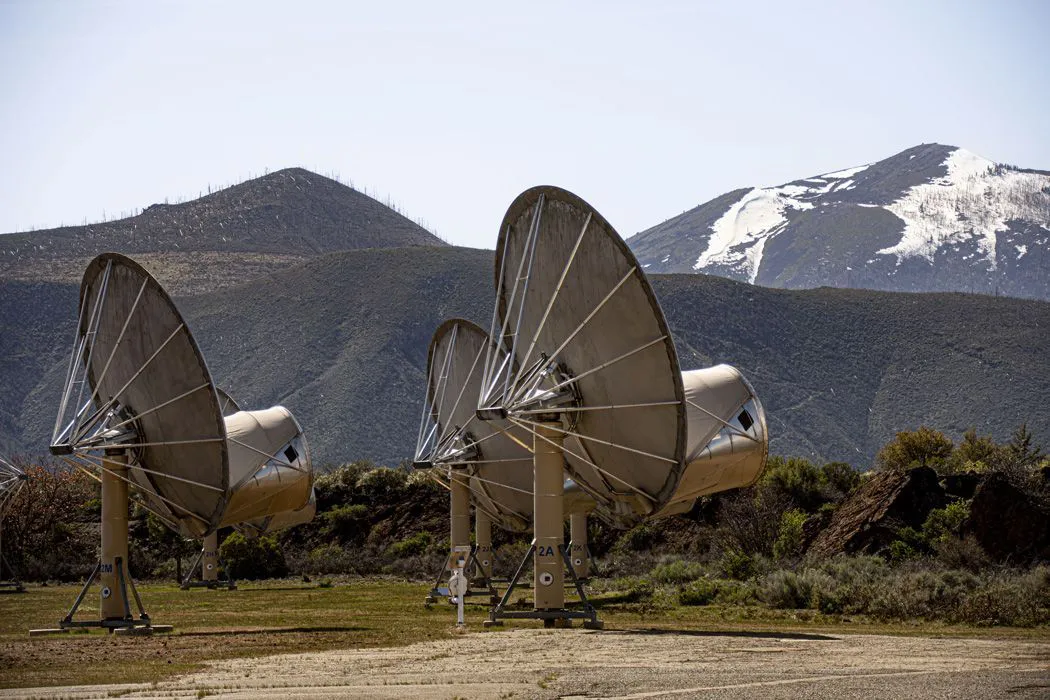The Search for Extraterrestrial Intelligence (SETI) is interested in finding alien civilisations by detecting signs of their activity.
The use of radio telescopes to listen out for alien broadcasts dates back to the 1960s, but SETI researchers also look for evidence of enormous engineering projects.
Read more

For example, an alien civilisation might construct a thin shell around its host star to harvest energy.
Such a ‘Dyson sphere’ ought to be detectable as a warm source of infrared rays without a corresponding visible light source.

Astronomers have looked for these telltale signatures but haven’t found any.
Many of these ‘technosignatures’ discussed by SETI researchers relate only to advanced civilisations, far beyond our current level of technological ability.

Turning the telescope on Earth
Sofia Sheikh, at the SETI Institute, California, and her colleagues are interested in a slightly different question.
How far away would Earth be detectable as harbouring an intelligent species, using only the technology we have today?
As the authors put it: "One could imagine a spaceship loaded with all of humanity’s best modern-day instruments, launched towards a mirror image of Earth – which present-day technosignatures would be detectable first?"
They look at a range of possible technosignatures: radio emissions; bright lasers shone into the sky; and changes to Earth’s atmospheric composition from agricultural and industrial activity.

Starting with radio emissions, the team calculated that if we beamed a signal with the intention of making contact, we’d be able to detect ourselves from around 12,000 lightyears away.
Of course, as attempts such as the 1974 Arecibo message have only been sent in the last century, any signals won’t have had time to make it nearly that far yet.
Meanwhile, inadvertent leaking of much weaker radio waves into outer space, from mobile phone towers or television broadcasts, would be detectable from four lightyears away – only as far as the nearest star to us.

Detecting Earth's industrial activity from outer space
Indicators of Earth's industrial activity in the atmosphere could be detected from slightly further away.
While nitrogen dioxide is produced by lightning and some biological processes on Earth, huge amounts of it are also released by human industrial activity: mainly vehicle engines and fossil-fuelled power stations.
Atmospheric nitrogen dioxide peaked in 1980 at levels that ought to be detectable from 5.7 lightyears away with the Habitable Worlds Observatory (HWO), a space telescope due to launch in the 2040s.
Light pollution is a big problem for astronomers in built-up areas, so might this urban technosignature be detectable?

Many cities are lit by the yellowy light from high-pressure sodium lamps, and this is particularly spectroscopically distinctive.
Sheikh’s team calculates that a telescope like the HWO could detect this artificial light from around 2,300 AU, where 1 AU is the Earth–Sun distance – an alien probe would need to be within the inner edge of our Solar System’s Oort cloud to see our nighttime cities.
Sheikh and her colleagues conclude that Earth is most detectable through radio emissions.
They stress that there are good reasons to not expect an extraterrestrial civilisation to have reached
exactly the same technological level as us, but this work does help focus attention on what sort of technosignatures we might be able to detect on exoplanets.
Lewis Dartnell was reading Earth Detecting Earth: At What Distance could Earth’s Constellation of Technosignatures be Detected with Present-day Technology? by Sofia Z Sheikh et al.
Read it online at: arxiv.org/abs/2502.02614
This article appeared in the May 2025 issue of BBC Sky at Night Magazine

